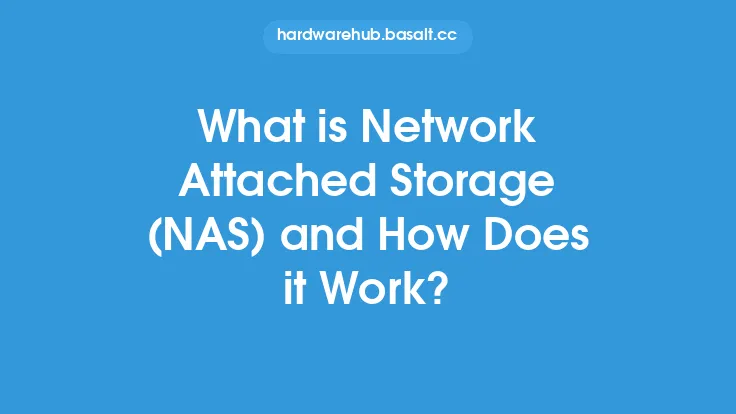Network Attached Storage (NAS) devices have become an essential part of modern computing, providing a centralized location for storing and sharing files across a network. At the heart of NAS devices are various protocols and technologies that enable them to communicate with other devices, manage data, and provide a range of services. In this article, we will delve into the world of NAS protocols and technologies, exploring the key concepts, architectures, and standards that underpin these devices.
Introduction to NAS Protocols
NAS devices use a variety of protocols to communicate with other devices on a network. These protocols define the rules and formats for exchanging data, ensuring that devices from different manufacturers can interoperate seamlessly. Some of the most common NAS protocols include NFS (Network File System), SMB (Server Message Block), AFP (Apple Filing Protocol), and FTP (File Transfer Protocol). Each protocol has its strengths and weaknesses, and the choice of protocol depends on the specific use case and requirements of the NAS device.
Network File System (NFS)
NFS is a widely used protocol for sharing files across a network. Developed by Sun Microsystems, NFS allows devices to access and share files as if they were local to the device. NFS uses a client-server architecture, where the NAS device acts as the server, and client devices access the shared files using the NFS protocol. NFS supports various versions, including NFSv2, NFSv3, and NFSv4, each offering improved performance, security, and functionality.
Server Message Block (SMB)
SMB is another popular protocol for sharing files and printers across a network. Developed by Microsoft, SMB is widely used in Windows environments, but it is also supported by other operating systems, including Linux and macOS. SMB uses a client-server architecture, where the NAS device acts as the server, and client devices access the shared files using the SMB protocol. SMB supports various versions, including SMBv1, SMBv2, and SMBv3, each offering improved performance, security, and functionality.
Apple Filing Protocol (AFP)
AFP is a protocol developed by Apple for sharing files and printers across a network. AFP is widely used in macOS environments, but it is also supported by other operating systems, including Linux and Windows. AFP uses a client-server architecture, where the NAS device acts as the server, and client devices access the shared files using the AFP protocol. AFP supports various versions, including AFPv2 and AFPv3, each offering improved performance, security, and functionality.
File Transfer Protocol (FTP)
FTP is a protocol for transferring files across a network. FTP uses a client-server architecture, where the NAS device acts as the server, and client devices access the shared files using the FTP protocol. FTP is widely used for transferring large files, such as videos and images, and is often used in conjunction with other protocols, such as NFS and SMB.
NAS Storage Technologies
In addition to protocols, NAS devices also employ various storage technologies to manage and store data. Some of the most common NAS storage technologies include RAID (Redundant Array of Independent Disks), JBOD (Just a Bunch of Disks), and SSD (Solid-State Drive) caching. RAID is a technology that combines multiple disks into a single logical unit, providing improved performance, capacity, and reliability. JBOD is a technology that allows multiple disks to be connected to a single controller, providing improved performance and capacity. SSD caching is a technology that uses solid-state drives to cache frequently accessed data, providing improved performance and responsiveness.
RAID Technologies
RAID is a widely used technology in NAS devices, providing improved performance, capacity, and reliability. There are several types of RAID, including RAID 0, RAID 1, RAID 5, and RAID 6, each offering different levels of performance, capacity, and redundancy. RAID 0 provides improved performance by striping data across multiple disks, but it offers no redundancy. RAID 1 provides improved redundancy by mirroring data across multiple disks, but it offers reduced capacity. RAID 5 and RAID 6 provide a balance between performance, capacity, and redundancy, making them popular choices for NAS devices.
SSD Caching Technologies
SSD caching is a technology that uses solid-state drives to cache frequently accessed data, providing improved performance and responsiveness. SSD caching can be implemented in various ways, including using a separate SSD cache device or using a portion of the NAS device's main storage as a cache. SSD caching can significantly improve the performance of NAS devices, especially in applications where data is frequently accessed, such as video editing and streaming.
NAS Security Technologies
NAS devices also employ various security technologies to protect data from unauthorized access and malicious attacks. Some of the most common NAS security technologies include encryption, authentication, and access control. Encryption technologies, such as AES (Advanced Encryption Standard), protect data by encrypting it with a secret key. Authentication technologies, such as username and password authentication, verify the identity of users and devices accessing the NAS device. Access control technologies, such as ACLs (Access Control Lists), control access to shared files and folders based on user identity and permissions.
Conclusion
In conclusion, NAS protocols and technologies are essential components of modern computing, providing a centralized location for storing and sharing files across a network. Understanding the various protocols and technologies used in NAS devices, including NFS, SMB, AFP, FTP, RAID, SSD caching, and security technologies, is crucial for selecting and configuring the right NAS device for specific use cases and requirements. By exploring the key concepts, architectures, and standards that underpin NAS devices, we can better appreciate the complexity and sophistication of these devices and make informed decisions about their use in our personal and professional lives.





